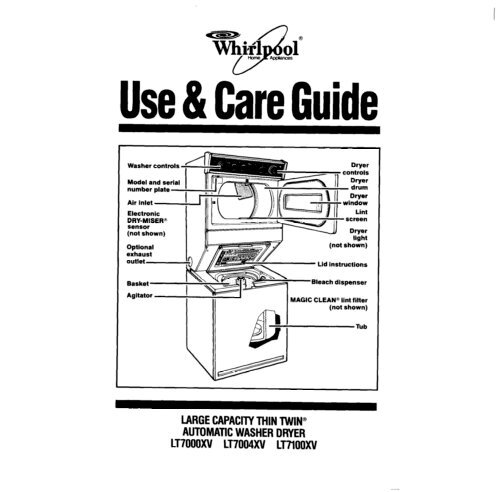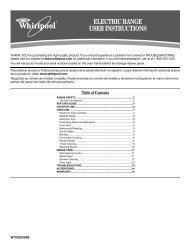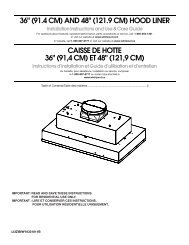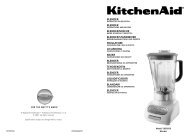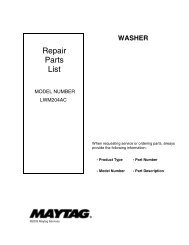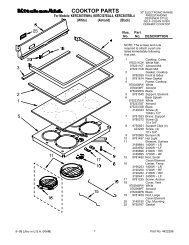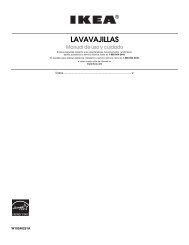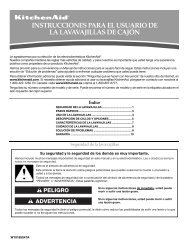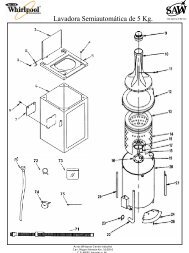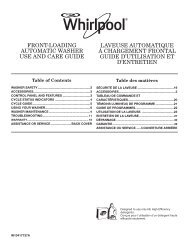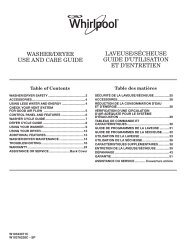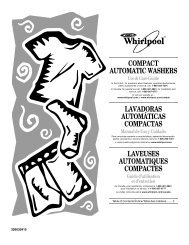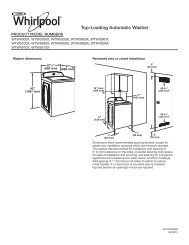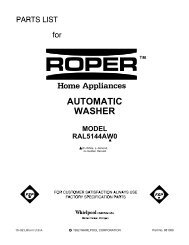I III - I LARGECAPACITYTHINTWIN" AUTOMATICWASHERDRYER ...
I III - I LARGECAPACITYTHINTWIN" AUTOMATICWASHERDRYER ...
I III - I LARGECAPACITYTHINTWIN" AUTOMATICWASHERDRYER ...
Create successful ePaper yourself
Turn your PDF publications into a flip-book with our unique Google optimized e-Paper software.
Washer controls<br />
Model and se<br />
number plate<br />
Air inlet<br />
Electronic<br />
DRY-MISER@<br />
sensor<br />
(not shown)<br />
exhaust<br />
j<br />
-!%==a<br />
r==? 1..<br />
Dryer<br />
controls<br />
Dryer<br />
\<br />
drum<br />
7111 Drver<br />
I Lint<br />
I<br />
I<br />
<strong>III</strong>‘<br />
Ill---- l<br />
--ii-<br />
-<br />
ir Screen r-.-uryer<br />
liaht .-=..-<br />
(not shown)<br />
Lid instructions<br />
leach dispenser<br />
MAGIC CLEAN@ lint filter<br />
I <strong>III</strong> - I (not shown)<br />
LARGECAPACITYTHINTWIN"<br />
<strong>AUTOMATICWASHERDRYER</strong><br />
LT7OOOxV LT7004xV LT7lOOXV<br />
Tub
Contents<br />
Important Safety<br />
Instructions. . . . . . . . . . . . . . . .<br />
Page<br />
3<br />
Additional safety instructions<br />
and your responsibilities . . . 4<br />
Loading Suggestions<br />
Loading . . . . . . . . . . . . . . . . . . . z<br />
Load sizes and water levels .<br />
Washer Operating Instructions<br />
Starting your washer . . . . . . . . 6<br />
What happens in each cycle 7<br />
Other Operating Instructions<br />
Rinse and spin . . . . . 11<br />
Drain and spin . . . . . . . . . . 11<br />
Soak cycle . . . . . . . . . 11<br />
Pre-wash cycle . . . . . . . . . . . . . 11<br />
Liquid bleach dispenser . . . . 12<br />
Liquid fabric softener<br />
dispenser . . . . . . . . . 12<br />
MAGIC CLEAN@ lint filter . . . . 13<br />
Dryer Operating Instructions<br />
Starting your dryer . . . . . . . . . . 14<br />
The automatic cycles . 15<br />
Timed drying cycle . . 16<br />
Usingdampdry . . . . . . . . . . . 16<br />
Using TUMBLE PRESS@ . 16<br />
Fluff air cycle . . . . . . . . . . . . . 16<br />
End-of-cycle signal . . . 16<br />
Gentle heat system . . . . . . . . . 16<br />
Selecting a cycle . . . . . . . . 17<br />
Changing the dryer light. . . . . . 18<br />
Lint Removal And Cleaning. . 19<br />
Cleaning the dryer window . . . 20<br />
If You Need Service Or<br />
Assistance. . . . . . 21<br />
Whirlpool Thin Twin@<br />
Warranty. . . . . 24<br />
01990 Whirlpool Corporation<br />
If your Thin Twin has a Consumer Buy<br />
Guide label, remove it. It will be easier<br />
to remove before the washer is used. To<br />
remove any remaining glue:<br />
l Rub briskly with thumb to make a ball,<br />
then remove.<br />
or<br />
l Soak area with liquid hand dishwash-<br />
ing detergent before removing glue as<br />
described above.<br />
Do not use sharp instruments,<br />
rubbing alcohol, flammable fluids or<br />
abrasive cleaners. These can damage<br />
the finish. See “Important Safety<br />
Instructions” on page 3.<br />
2<br />
NOTE: Do not remove any permanent<br />
instruction labels inside the dryer.<br />
You should wipe out the dryer drum<br />
with a damp cloth before using to re-<br />
move dust from storing or shipping.<br />
Thank you for buying a Whirlpool ap-<br />
pliance. Please complete and mail the<br />
Owner Registration Card provided with<br />
this product. Then complete the form<br />
below. Have this information ready if<br />
you need service or call with a question.<br />
l Copy model and serial numbers from<br />
plate (next to dryer drum opening)<br />
and the purchase date from the sales<br />
slip.<br />
l Keep this book, the Laundry Guide<br />
and the sales slip in a handy place.<br />
Model Number<br />
Serial Number<br />
Purchase Date<br />
Service Company Phone Number<br />
FOR YOUR SAFETY<br />
If you smell gas:<br />
1. Open windows.<br />
2. Don’t touch electrical<br />
switches.<br />
3. ;fceguish any open<br />
.<br />
4. Immediately call your<br />
gas supplier.<br />
FOR YOUR SAFETY<br />
Do not store or use gas-<br />
oline or other flammable<br />
vapors and liquids in the<br />
vicinity of this or any<br />
other appliance. The<br />
fumes can create a fire<br />
hazard or explosion.
Important Safety Instructions<br />
To reduce the risk of fire, electric shock, or in-<br />
jury to persons when using your Thin Twin, fol-<br />
low basic precautions, including the following:<br />
b Read all instructions<br />
using the Thin Twin.<br />
before l NEVER use or store flammable<br />
fluids (dry-cleaning solvents,<br />
l NEVER wash or dry items cleaned,<br />
washed, soaked in or spotted with<br />
wax, paint, gasoline or flammable<br />
fluids in the Thin Twin. The fumes<br />
can create a FIRE HAZARD or EX-<br />
PLOSION. ALWAYS hand launder<br />
gasoline, kerosene) in or near your<br />
Thin Twin. Do not add flammable<br />
fluids to the wash water. These<br />
substances give off vapors that<br />
can create a FIRE HAZARD or<br />
EXPLOSION.<br />
and air dry fabrics containing these l Use only dryer fabric softeners<br />
materials. specifically labeled as not being<br />
l NEVER allow children to operate, harmful to the dryer.<br />
play with, or crawl inside the Thin l FIRE HAZARD and DAMAGE to<br />
Twin. Close supervision of children is materials can result from:<br />
necessary when the Thin Twin is<br />
used near children.<br />
- drying rubber, rubber-like and<br />
heat sensitive materials with heat.<br />
l When discarding an old Thin Twin, - allowing lint to build-up inside<br />
ALWAYS remove the lid and door to the dryer or exhaust system -<br />
prevent accidental entrapment. cleaning should be done by a<br />
l NEVER reach into the Thin Twin qualified person.<br />
until all the motion stops. If the lid is l Clean lint screen before or after<br />
opened while the washer basket is each load.<br />
spinning, the basket will automatitally<br />
stop in a few seconds.<br />
. DO NOT install or store Thin Twin<br />
l If hot water has not been used<br />
recently (usually 2 weeks or longer),<br />
hydrogen gases may build up in<br />
where it will be exposed to the the water heater and the hot water<br />
weather. pipes. HYDROGEN GAS IS<br />
l<br />
l<br />
DO NOT tamper with the controls.<br />
You are responsible for making<br />
sure that your Thin Twin is<br />
installed, repaired and parts<br />
replaced by a qualified person.<br />
EXPLOSIVE. To prevent injury or<br />
damage, before using your washer,<br />
turn on all hot water faucets and allow<br />
water to run for several minutes.<br />
This will allow gases to escape. DO<br />
NOT smoke or use any open flame<br />
near the faucet while it is open.<br />
l DO NOT let dust, paper, rags, lint,<br />
chemicals, etc. pile up, around or<br />
l<br />
under the Thin Twin.<br />
The Thin Twin must be electrically<br />
grounded. See the Installation<br />
Instructions.<br />
- SAVE THESE INSTRUCTIONS -
Important Safety Instructions<br />
Continued<br />
Additional safety instructions<br />
and your responsibilities<br />
l ALWAYS shut off the gas valve<br />
before leaving on vacation.<br />
l ALWAYS unplug the power supply<br />
cord before attempting to service the<br />
Thin Twin. Shut off GAS VALVE if<br />
yours is a gas dryer.<br />
l DO NOT machine wash or dry glass<br />
fiber materials. Small particles can<br />
stick to fabrics laundered in following<br />
loads and cause skin irritation.<br />
l HAZARDOUS FUMES can be<br />
formed if chlorine bleach is used in<br />
the same wash as ammonia or acids<br />
such as vinegar or rust remover.<br />
l ALWAYS store detergent, laundry<br />
aids and other materials in a cool, dry<br />
place where children can’t reach them<br />
- in a locked cabinet if possible.<br />
l ALWAYS read and follow instructions<br />
on packages of detergent and laundry<br />
aids - especially warnings and<br />
precautions.<br />
4<br />
l NEVER operate the Thin Twin if..<br />
- it is not working right.<br />
- it is damaged.<br />
- parts are missing.<br />
- all panels are not in place.<br />
l You areresponsible for making<br />
sure that your Thin Twin:<br />
- is properly maintained.<br />
- is properly installed and<br />
leveled in a well ventilated room on<br />
a floor that can support the weight.’<br />
- is located in an area where the tem-<br />
perature is above 45°F (7.2%)<br />
because the dryer will not operate<br />
properly at cold temperatures and<br />
freezing temperatures can damage<br />
the washer.<br />
- is connected to the proper electrical<br />
supply, outlet, water supply, plumb-<br />
ing fixtures, drain and dryer<br />
exhausting system.’<br />
- is not installed against drapes or<br />
curtains.*<br />
- is used only for jobs normally<br />
expected of home automatic<br />
Thin Twins.<br />
*Refer to the Installation Instructions for<br />
complete information.<br />
When not washing, keep both water<br />
faucets turned off. This takes the pres-<br />
sure off the water inlet valve and hoses.
Loading Suggestions<br />
Loading<br />
MIXED LOAD<br />
2 double or 1<br />
king size sheet<br />
4 pillowcases<br />
6 T-shirts<br />
6 pair shorts<br />
2 shirts<br />
2 blouses<br />
6 handkerchiefs<br />
HEAVY WORK<br />
CLOTHES<br />
2 pair pants<br />
3 shirts<br />
1 coverall<br />
3 pair jeans<br />
TOWELS<br />
8 bath towels<br />
8 hand towels<br />
10 wash cloths<br />
1 bathmat<br />
PERMANENT<br />
PRESS<br />
1 double sheet<br />
1 tablecloth<br />
1 dress<br />
1 blouse<br />
2 slacks<br />
3 shirts<br />
2 pillowcases<br />
KNITS<br />
2 slacks<br />
2 tops<br />
4 blouses<br />
4 shirts<br />
2 dresses<br />
DELICATES<br />
2 camisoles<br />
4 slips<br />
4 panties<br />
2 bras<br />
2 nighties<br />
Load sizes and water levels<br />
For best cleaning results, the load must<br />
be able to move freely in the water. Too<br />
big a load or too little water can cause<br />
wear or tearing of load items.<br />
(13.4 gals.EO.8 L)’<br />
- EX SMALL<br />
(9.5 galsJ36.0 L)’<br />
*Approximate fill with load.<br />
NOTE: Do not overload washer.
Washer Operating Instructions<br />
The drawings in this book may vary slightly from your Thin Twin model. They are<br />
designed to show the different features of all the models covered by this book.<br />
NOTE: Your model may not include all the features shown.<br />
Starting your washer<br />
Be sure to measure and add detergent, then place a sorted load in the washer before<br />
starting it.<br />
6<br />
1. Select a load size<br />
l Turn the knob to point at a setting that<br />
describes the size of load you want<br />
to wash.<br />
l Set the knob anywhere on or between<br />
EX SMALL (a few small items) and<br />
EX LARGE (a full load).<br />
l To change the water level after the<br />
washer has started to fill, turn the<br />
knob to RESET then to the desired<br />
water level.<br />
NOTE: For best washing results, items<br />
should move freely in the washer. Do<br />
not overload the washer or choose a<br />
water level that is too low for your wash<br />
load.<br />
For best results with permanent<br />
press clothes, use the EX LARGE water<br />
level.<br />
Reduce wash time when using EX<br />
SMALL or SMALL water level settings.<br />
Loads with only a few small items need<br />
less wash time for best results.<br />
2. Select water temperature<br />
l Match the water temperature to<br />
the type of fabric and soils being<br />
washed.<br />
l The top temperature is the wash<br />
selection and the bottom tempera-<br />
ture is the rinse selection.<br />
NOTE: Use warm wash water with<br />
the PERMANENT PRESS or KNITS<br />
GENTLE Cycles.<br />
For heavily soiled permanent press<br />
or knit clothes, pre-wash or pre-soak<br />
before washing in warm water.<br />
ALWAYS use cold rinse water for<br />
permanent press fabrics.
3. Select cycle and wash time<br />
Start the washer<br />
l Push in the Cycle Control Knob and<br />
turn it clockwise.<br />
l Stop when the indicator on the knob’s<br />
outer ring points to the number in the<br />
wash cycle you want. The numbers<br />
are minutes of wash time.<br />
l Start the washer by pulling out the<br />
Cycle Control Knob. The washer will<br />
fill to the selected water level with the<br />
selected wash water temperature.<br />
After filling, the washer will agitate for<br />
the selected number of minutes.<br />
l To stop the washer at any time,<br />
push in the Cycle Control Knob. To<br />
restart the washer, pull out the<br />
Cycle Control Knob.<br />
What happens in each cycle<br />
Each cycle has different agitation and<br />
spin speeds designed for different kinds<br />
of fabrics.<br />
Numbers on the dial in each cycle are<br />
the minutes of wash agitation time.<br />
When the Cycle Control Knob is set<br />
to a number and pulled out, the washer<br />
fills before agitation and timing starts.<br />
After agitation starts, the knob turns<br />
clockwise until it points to OFF and the<br />
cycle ends.<br />
The washer will pause briefly<br />
throughout each cycle. These pauses<br />
are normal. They allow for the reversing<br />
of the motor, normal washer operation<br />
and the cool-down portion of the<br />
PERMANENT PRESS Cycle.<br />
NOTE: You may hear the sound of<br />
water spraying during the spin parts of<br />
some cycles. In some cycles, water is<br />
sprayed on the spinning load to help<br />
with the rinsing.<br />
Gentle Wash System<br />
For better fabric care in the REGULAR<br />
and PERMANENT PRESS Cycles, the<br />
agitation speed is reduced during the<br />
last few minutes of wash agitation time.<br />
7
Washer Operating Instructions<br />
Continued<br />
Regular Cycle<br />
A cycle for sturdily constructed fabrics<br />
that are moderately to heavily soiled.<br />
to Selected Level<br />
High Speed, Spray Rinses<br />
Permanent Press Cycle<br />
A cycle designed for lightly to moder-<br />
ately soiled permanent press and some<br />
synthetic fabrics. The cool-down rinse<br />
helps keep wrinkles from setting into<br />
these items.<br />
to Selected Level<br />
SPIN Low Speed<br />
FILL for Deep Rinse<br />
NOTE: Always use cold rinse water<br />
for permanent press fabrics.<br />
I
Knits Gentle Cycle<br />
A cycle that gently washes and spins<br />
moderately to lightly soiled delicate<br />
items and washable knits.<br />
to Selected Level<br />
Low Speed, Spray Rinses<br />
Alndicates that machine is pausing<br />
for a brief soak period.<br />
Soak and Pre-Wash Cycles<br />
Brief periods of agitation and soak time<br />
help remove heavy soils and certain<br />
stains that need extra pretreatment.<br />
Use recommended amount of detergent<br />
or presoak additive. The SOAK Cycle<br />
should always be followed by a wash<br />
cycle.<br />
to Selected Level<br />
2 Minutes High Speed<br />
8 Minutes No Agitation<br />
NOTE: The pre-wash setting starts the<br />
washer at the second wash period.<br />
Special care is needed when soaking<br />
or pre-washing laundry. See the Laun-<br />
dry Guide for proper use.<br />
9
Washer Operating Instructions<br />
Continued<br />
Super Wash Cycle<br />
Use for washing heavrly soiled loads<br />
that require maximum soil removal.<br />
Double the amount of detergent recom-<br />
mended when using the SUPER WASH<br />
Cycle.<br />
to Selected Level<br />
PARTIAL DRAIN No Agitation<br />
lo Selected Level<br />
After the partial drain, the washer<br />
automatically refills and goes into the<br />
REGULAR Cycle. Be sure to use<br />
enough detergent for the double wash.<br />
10
Other Operating Instructions<br />
Rinse and spin<br />
When using extra detergent for heavily<br />
soiled clothes, or washing special-care<br />
items, you may want an extra rinse<br />
and spin.<br />
1. Push Cycle Control Knob in.<br />
2. Turn clockwise to one of the dots on<br />
the dial, as illustrated.<br />
3. Pull Cycle Control Knob out. The<br />
washer will fill to selected level,<br />
agitate 2-4 minutes depending on<br />
the cycle selected, drain and spin.<br />
Soak Cycle<br />
For best results, use warm water for<br />
soaking stained laundry. Hot water can<br />
set stains.<br />
1. Use recommended amount of<br />
pre-soak product or detergent.<br />
2. Push Cycle Control Knob in.<br />
3. Turn clockwise to point to the<br />
number next to SOAK.<br />
4. Pull the Cycle Control Knob out.<br />
The washer will start.<br />
5. When the cycle is over, add<br />
detergent for the next selected wash<br />
cycle. The SOAK Cycle should al-<br />
ways be followed by a wash cycle.<br />
NOTE: See the Laundry Guide for<br />
additional soaking information.<br />
Pre-wash Cycle<br />
For best results, use warm water for<br />
pre-washing stained laundry. Hot water<br />
can set stains.
Other Operating Instructions<br />
Continued<br />
12<br />
1. Use recommended amount of<br />
presoak product or detergent,<br />
2. Push Cycle Control Knob in.<br />
3. Turn clockwise to point to the<br />
number next to PRE-WASH.<br />
4. Pull the Cycle Control Knob out.<br />
The washer will start.<br />
5. When the cycle is over, add<br />
detergent for the next selected wash<br />
cycle. The PRE-WASH Cycle should<br />
always be followed by a wash cycle.<br />
NOTE: See the Laundry Guide for<br />
additional pre-washing information.<br />
Liquid bleach dispenser<br />
Always measure bleach. Do not guess.<br />
Never use more than 1 cup (250ml) for<br />
a full load. Use less with lower water<br />
level settings. Follow directions on<br />
bottle for safe use. Use a cup with a<br />
pouring spout to avoid spilling.<br />
1. Load the washer first.<br />
2. Pour measured bleach carefully into<br />
dispenser. Do not let bleach splash,<br />
drip or run down into washer basket.<br />
Undiluted bleach will damage any<br />
fabric it touches.<br />
3. Start the washer. Bleach will be<br />
diluted automatically during the<br />
wash part of the cycle.<br />
Liquid fabric softener<br />
dispenser<br />
A liquid fabric softener dispenser is<br />
available for the washer. Write to:<br />
Whirlpool Corporation<br />
Attention: Customer Service Dept.<br />
1900 Whirlpool Drive<br />
LaPorte, IN 46305<br />
and order the LT7000XT fabric softener<br />
dispenser, Part No. 3350634.
MAGIC CLEAN@ lint filter<br />
The lint filter at the bottom of the<br />
washer basket cleans itself. During agi-<br />
tation, wash and rinse water pass over<br />
the filter, separating lint from water.<br />
The collected particles of lint are then<br />
continuously spun away from the filter<br />
and washed out of the system at the<br />
end of the wash cycle.<br />
If your washer drains into a tub,<br />
remove any lint collected in the tub<br />
or strainer.
Dryer Operating Instructions<br />
Starting your dryer<br />
Before starting your dryer, be sure laundry IS sorted and loaded properly. Make sure<br />
the door is tightly closed.<br />
14<br />
1. Select a cycle and time by turning<br />
the Cycle Control Knob either way to<br />
point to the cycle and time setting<br />
you want.<br />
2. Set the Temperature Selector on<br />
or between any desired temperature<br />
settings.<br />
3. Push the Start Button to start the<br />
set drying cycle and time settings.<br />
4. To stop and restart the dryer:<br />
l Open the door or turn the Cycle Con-<br />
trol Knob to OFF to stop the dryer.<br />
l Close the door, select a cycle (if nec-<br />
essary) and push the Start Button to<br />
restart the dryer.<br />
5. To change the setting at any time,<br />
turn the Cycle Control Knob either<br />
way to point to a new time setting.<br />
The Cycle Control Knob should<br />
point to an OFF area when the dryer<br />
is not in use. If the dryer is stopped<br />
before the cycle is finished, turn the<br />
Cycle Control Knob to an OFF area.
The automatic cycles<br />
The automatic cycles allow you to<br />
select the degree of dryness you prefer<br />
for the clothes being dried.<br />
The electronic DRY-MISER@ control<br />
is an electronic sensor that determines<br />
the amount of moisture in the clothes.<br />
The dryer automatically shuts off when<br />
the proper dryness is reached.<br />
The Cycle Control Knob will not move<br />
until the clothes load is almost dry, or<br />
the Cool-Down portion of the cycle has<br />
been reached. After the Cool-Down<br />
portion is complete, the Cycle Control<br />
Knob automatically moves to an OFF<br />
area and tumbling stops.<br />
For the first few loads, set the Cycle<br />
Control Knob to point to the * in either<br />
automatic cycle. When the dryer stops,<br />
feel the dried items.<br />
l If items are drier than you like, use a<br />
setting to the right of the * the next<br />
time you dry a similar load.<br />
l If items are not as dry as you like, use<br />
a setting lo the left of the *the next<br />
time you dry a similar load.<br />
NOTE: Overdrying can cause<br />
shrinkage, static cling and damage to<br />
some fabrics.<br />
15
Dryer Operating Instructions<br />
Continued<br />
TIMED DRYING cycle<br />
Use the TIMED DRYING Cycle for any<br />
load you want to dry by time.<br />
l Turn the Cycle Control Knob to the<br />
number of minutes you want.<br />
l The last 8 minutes of this cycle<br />
are without heat. This helps make<br />
the load easier to handle.<br />
Using DAMP DRY<br />
Use this setting to dry damp items that<br />
do not require an entire drying cycle, or<br />
to dry items to damp level. (Two exam-<br />
ples are heavy cottons, such as jeans,<br />
which you do not want to become stiff,<br />
or cotton clothes which are easier to<br />
press when damp.)<br />
1. Set the Cycle Control Knob on<br />
DAMP DRY in the PERMANENT<br />
PRESS Cycle.<br />
2. Push the Start Button.<br />
The dryer tumbles the load with heat<br />
for 22 minutes, then without heat for<br />
8 minutes.<br />
Using TUMBLE PRESS”<br />
The TUMBLE PRESS setting removes<br />
wrinkles from clothing that has been<br />
packed in a suitcase or closet, and from<br />
items not removed from the dryer at the<br />
end of a cycle.<br />
The load will tumble in heated air for<br />
12 minutes. The heat shuts off and the<br />
dryer continues to tumble for 8 minutes.<br />
For best results, put only a few items<br />
at a time in this cycle. As soon as the<br />
dryer stops, put items on hangers or<br />
fold them.<br />
16<br />
FLUFF AIR cycle<br />
Fire Hazard<br />
Do not dry plastic or rubber items<br />
with heat. Use AIR setting, or line<br />
dry. Failure to do so could result<br />
in fire or damaged items.<br />
The dryer does not heat when the Cycle<br />
Control Knob is set in FLUFF AIR. This<br />
cycle can be used to fluff or air dry bed-<br />
ding, plastic tablecloths, foam rubber<br />
pillows, stuffed toys, sneakers, etc.<br />
1. Turn the Cycle Control Knob to the<br />
number of minutes you want in<br />
FLUFF AIR.<br />
2. Push the Start Button.<br />
End-of-cycle signal<br />
The dryer sounds a signal to let you<br />
know when the cycle is finished. The<br />
signal cannot be turned off and is<br />
not adjustable.<br />
The signal is helpful when you are<br />
drying permanent press, synthetic and<br />
other items that should be taken out<br />
as soon as the dryer stops.<br />
Gentle Heat system<br />
The dryer automatically reduces the<br />
heat during the last few minutes of each<br />
drying cycle, before cool-down. This<br />
helps prevent overdrying.
Selecting a cycle<br />
TYPE OF LOAD<br />
SUGGESTED SUGGESTED<br />
CYCLE TEMPERATURE<br />
Cottons and linens AUTOMATIC REGULAR<br />
EXTRA HEAVY - Bedspreads, mattress HEAVY HIGH<br />
pads, quilts<br />
HEAVYWEIGHT-Towels, jeans,<br />
corduroys, work clothes<br />
MEDIUMWEIGHT- Sheets, pillowcases, PERM’T PRESS<br />
cotton, underwear, diapers MED<br />
LIGHTWEIGHT - Batistes, organdies, KNITS GENTLE<br />
lingerie LOW<br />
Permanent press, synthetics<br />
and blends<br />
HEAVYWEIGHT-Work clothes,<br />
jackets, raincoats<br />
MEDIUMWEIGHT - Shirts, play clothes,<br />
sheets, slacks<br />
LIGHTWEIGHT - Lingerie, blouses,<br />
dresses<br />
Knits<br />
HEAVYWEIGHT-Cottons, rayons,<br />
blends, T-shirts, slacks, shirts<br />
LIGHTWEIGHT - Synthetic (polyester,<br />
acrylic, etc.) and blends, lingerie,<br />
blouses, dresses<br />
Delicate fabrics<br />
Sheer curtains (2 or 3 panels), gauze,<br />
lace, etc.<br />
Rubber, plastic,<br />
heat-sensitive fabrics<br />
FOAM RUBBER - Pillows, bras,<br />
stuffed toys<br />
PLASTIC - Shower curtains, tablecloths<br />
RUBBER-BACKED RUGS<br />
OLEFIN, POLYPROPYLENE,<br />
SHEER NYLON<br />
AUTOMATIC<br />
PERMANENT PRESS<br />
AUTOMATIC<br />
PERMANENT PRESS<br />
AUTOMATIC<br />
PERMANENT PRESS<br />
FLUFF AIR<br />
20 minutes<br />
20 minutes<br />
20 minutes<br />
15-20 minutes<br />
PERM’T PRESS<br />
MED<br />
MEDIUM LOW<br />
MEDIUM LOW<br />
KNITS GENTLE<br />
LOW<br />
EX LOW<br />
(No temperature<br />
needs to be<br />
selected.<br />
Cycle is<br />
unheated.)<br />
DO NOT OVERDRY. Overdrying can cause shrinkage, static cling, and damage<br />
some fabrics.
Dryer Operating Instructions<br />
Continued<br />
Changing the dryer light<br />
Electrical Shock Hazard<br />
Unplug the power supply cord or<br />
turn off the electrical power<br />
before changing the light bulb.<br />
Failure to do so may result in<br />
electrical shock.<br />
The dryer light is located inside the<br />
dryer drum on the front wall. To replace<br />
the light:<br />
1. Unplug unit from electrical supply or<br />
turn off electrical power.<br />
2. Open dryer door. Remove screw<br />
holding lens.<br />
3. Remove lens by pulling it down and<br />
away from drum.<br />
4. Pivot bulb out of holder by pulling on<br />
top of bulb.<br />
5. Remove bulb by turning it<br />
counterclockwise.<br />
6. Replace with a 25 watt, 120 volt,<br />
bayonet bulb (DC-type base), avail-<br />
able at most hardware or department<br />
stores.<br />
7. Place the top of the lens onto the<br />
top of the holder. Rotate the bottom<br />
of the lens down until it is in place.<br />
Replace screw. Reconnect power.<br />
18<br />
NOTE: It is very important that the lens<br />
be replaced properly before dryer<br />
is plugged in or electrical supply is<br />
turned on.<br />
Fire and<br />
Fabric Damage Hazard<br />
The dryer light lens must be<br />
securely in place before operating<br />
dryer. Failure to do so may result<br />
in fire hazard or fabric damage.
Lint Removal And Cleaning<br />
Clean the lint screen before<br />
each load.<br />
The lint screen is located at the front<br />
of the dryer door opening. To clean:<br />
1. Lift screen straight up.<br />
2. ROLL lint off the screen with your<br />
fingers. DO NOT rinse or wash<br />
the screen.<br />
3.Replace the screen.<br />
Clean lint gathered in screen area.<br />
Periodically remove the dryer lint<br />
screen and vacuum the opening. Use<br />
the long, thin attachment (crevice tool)<br />
on your vacuum cleaner.<br />
Fire Hazard<br />
Do not run the dryer with the lint<br />
screen loose, damaged, blocked<br />
or missing. Doing so can cause<br />
overheating, damage and be a fire<br />
hazard.
Lint Removal and Cleaning<br />
Continued<br />
20<br />
I<br />
Heat Inlet Thern!ostat<br />
duct<br />
I<br />
ElectrIcal<br />
SUPPlY<br />
Motor<br />
Clean lint gathered inside the dryer.<br />
Lint can gather inside the dryer and<br />
create a FIRE HAZARD. This lint<br />
should be removed at least every<br />
2 to 3 years, or more often,<br />
depending on dryer usage.<br />
Electrical Shock and<br />
Personal Injury Hazard<br />
l Unplug the power supply cord<br />
or turn off the electrical power<br />
before lint removal.<br />
l Do not put hands inside the<br />
cabinet.<br />
l Make sure the dryer is cool.<br />
l More than one person is<br />
required to lift, tilt or move the<br />
washer/dryer because of its<br />
weight and size.<br />
Failure to do so could result in<br />
electrical shock, injury or<br />
damage.<br />
Cleaning should be done only by a<br />
qualified person.<br />
1. Unplug unit from electrical supply<br />
or turn off electrical power.<br />
2. Remove back panel from dryer.<br />
3. Avoid touching wires and thermostats.<br />
4. Remove lint from boxed-in area with<br />
a soft brush or vacuum cleaner.<br />
5. Replace back panel, reconnect and<br />
level the Thin Twin.<br />
Cleaning the dryer window<br />
Use spray glass cleaner and a soft<br />
cloth when cleaning the window in the<br />
dryer door.<br />
l Make sure the dryer is cool.<br />
l Follow directions provided with the<br />
cleaner.<br />
l Wash, rinse and dry well.<br />
NOTE: See the Laundry Guide for<br />
additional cleaning information.
If You Need Service Or Assistance.. .<br />
We suggest you follow<br />
these steps:<br />
1. Before calling for assistance...<br />
Performance problems often result from<br />
little things you can find and fix yourself<br />
without tools of any kind.<br />
If your washer does not fill:<br />
l Is the power supply cord plugged into<br />
a live circuit with the proper voltage?<br />
l Are both water faucets open?<br />
l Have you checked your home’s main<br />
fuses or circuit breaker box?<br />
l Are the water supply hoses kinked?<br />
l Is the Cycle Control Knob set and<br />
pulled out?<br />
If your washer does not spin:<br />
l Is the lid closed?<br />
l Is the power supply cord plugged into<br />
a live circuit with the proper voltage?<br />
l Have you checked your home’s main<br />
fuses or circuit breaker box?<br />
If your washer drains at the<br />
wrong time:<br />
l The drain hose should be at least 28<br />
inches above the floor and secured.<br />
l The drain hose should not fit tightly in<br />
the drain pipe.<br />
l Make sure that the Cycle Control<br />
Knob is pointing to a number in the<br />
cycle.<br />
Make sure the drain hose is higher<br />
than the water level in the washer.<br />
If it isn’t...<br />
l The washer may seem to be draining<br />
during wash and rinse cycles.<br />
l Water can siphon out. (See Installa-<br />
tion Instructions.)<br />
If your washer stops during<br />
a cycle:<br />
l Remember, the washer pauses briefly<br />
at different times in each cycle. These<br />
pauses are normal.<br />
If your dryer does not run:<br />
l IS the power supply plugged into a live<br />
circuit with the proper voltage?<br />
l Is the door closed tightly?<br />
l Did you push the START Button?<br />
l Have you checked your home’s main<br />
fuses or circuit breaker box?<br />
If your dryer does not heat:<br />
l The FLUFF AIR setting is without<br />
heat.<br />
l The last few minutes of heated cycle<br />
settings are without heat.<br />
l An electric dryer circuit uses 2 break-<br />
ers or 2 fuses. If one breaker is tripped<br />
or one fuse is blown, the dryer may<br />
run, but not heat.<br />
If drying time seems too long:<br />
. Is the gas turned on? If not, turn the<br />
Cycle Control Knob to OFF. Turn on<br />
gas. Wait 5 minutes. Reset controls<br />
and start.<br />
l Is the lint screen clean? See page 19<br />
of this book for cleaning instructions.<br />
l Is exhaust system clean? Cleaning<br />
should be done by a qualified person.<br />
2. If you need assistance’..<br />
Call Whirlpool COOL-LINE@<br />
service assistance telephone<br />
number. Dial free from anywhere<br />
in the U.S.:<br />
l-6W-253-1301<br />
and talk with one of our trained consul-<br />
tants. The consultant can instruct you in<br />
how to obtain satisfactory operation<br />
from your appliance or, if service is nec-<br />
essary, recommend a qualified service<br />
company in your area.<br />
If you prefer, write to:<br />
Mr. Donald Skinner<br />
Director of Consumer Relations<br />
Whirlpool Corporation<br />
2000 M-63<br />
Benton Harbor, Ml 49022<br />
Please include a daytime phone<br />
number in your correspondence.<br />
21
If You Need Service Or Assistance<br />
Continued<br />
3. If you need service’...<br />
Whirlpool has a<br />
zi.*l elm ~~~~~~~&~twork<br />
46^<br />
ssnvrcs WhirlpoolSM service<br />
companies.<br />
Whirlpool service technicians are trained<br />
to fulfill the product warranty and provide<br />
after-warranty service, anywhere in the<br />
United States. To locate the authorized<br />
Whirlpool service company in your area,<br />
call our COOL-LINE@ service assistance<br />
telephone number (see Step 2) or look in<br />
your telephone<br />
under:<br />
directory Yellow Pages<br />
SERVICE COMP.~N,ES<br />
XYZ SERVICE co<br />
123 MAPLE 999-9999<br />
4. If you need FSP@<br />
replacement parts+...<br />
FSP is a registered trademark of<br />
Whirlpool Corporation for quality parts.<br />
Look for this symbol of quality when-<br />
ever you need a replacement part for<br />
your Whirlpool appliance. FSP replace-<br />
ment parts will fit right and work right,<br />
because they are made to the same<br />
exacting specifications used to build<br />
every new Whirlpool appliance.<br />
To locate FSP replacement parts<br />
in your area, refer to Step 3 or call the<br />
Whirlpool COOL-LINE service<br />
assistance number in Step 2.<br />
22<br />
5. If you are not satisfied with<br />
how the problem was solved’...<br />
l Contact the Major Appliance<br />
Consumer Action Panel (MACAP).<br />
MACAP is a group of independent<br />
consumer experts that voices con-<br />
sumer views at the highest levels of<br />
the major appliance industry.<br />
l Contact MACAP only when the<br />
dealer, authorized servicer or<br />
Whirlpool have failed to resolve<br />
your problem.<br />
Major Appliance Consumer<br />
Action Panel<br />
20 North Wacker Drive<br />
Chicago, IL 60606<br />
l MACAP will in turn inform us of<br />
your action.<br />
‘When requesting assistance, please<br />
provide: model number, serial number,<br />
date of purchase, and a complete<br />
description of the problem. This infor-<br />
mation is needed in order to better<br />
respond to your request.
Notes<br />
23
-<br />
Whirlpool” Thin Twin@ Warranty<br />
TTOOZ<br />
.ENGTH OF WARRANTY 1 WHIRLPOOL WILL PAY FOR<br />
:ULL ONE-YEAR<br />
WARRANTY<br />
Yom Date of Purchase<br />
.IMITED FIVE-YEAR<br />
WARRANTY<br />
Yom Date of Purchase<br />
FSP@ replacement parts and repair labor to<br />
correct defects in materials (including top and lid<br />
rust) or workmanship. Service must be provided<br />
by an authorized Whirlpool” service company.<br />
FSP replacement parts for any part of<br />
gearcase assembly if defective in materials<br />
or workmanship. The gearcase assembly<br />
is shown below.<br />
FSP reolacement Darts for anv too and lid rust.<br />
.IMITED TEN-YEAR FSP replacement of outer tub should it crack, or<br />
WARRANTY fail to contain water, due to defective materials<br />
:rom Date of Purchase or workmanshio.<br />
WHIRLPOOL WILL NOT PAY FOR<br />
A. Service calls to:<br />
1. Correct the installation of the washer/dryer.<br />
2. Instruct you how to use the washer/dryer.<br />
3. Replace house fuses or correct house wiring or plumbing.<br />
4. Replace light bulbs.<br />
B. Repairs when washer/dryer is used in other than normal, single-family<br />
household use.<br />
C. Pick up and delivery. This product is designed to be repaired in<br />
the home.<br />
D. Damage to washer/dryer caused by accident, misuse, fire, flood, acts of<br />
God or use of products not approved by Whirlpool.<br />
E. Any labor costs during the limited warranties.<br />
WHIRLPOOL CORPORATION SHALL NOT BE LIABLE FOR INCIDENTAL OR<br />
CONSEQUENTIAL DAMAGES. Some states do not allow the exclusion or limitation<br />
of incidental or consequential damages so this limitation or exclusion may not<br />
apply to you. This warranty gives you specific legal rights, and you may also have<br />
other rights which vary from state to state.<br />
Outside the United States, a different warranty may apply. For details, please<br />
contact your franchised Whirlpool distributor or military exchange.<br />
If you need service, first see the ‘Service and Assistance” section of this book.<br />
After checking “Service and Assistance;’ additional help can be found by calling<br />
our COOL-LINE@ service assistance telephone number, l-800-253-1301, from<br />
anywhere in the U.S. Gearcase assembly<br />
covered by your<br />
warranty<br />
@Registered Trademark/<br />
SM Service Mark of<br />
Whirlpool Corporation<br />
Part No. 3391364<br />
01990 Whirlpool Corporation<br />
Printed in U.S.A.<br />
-


